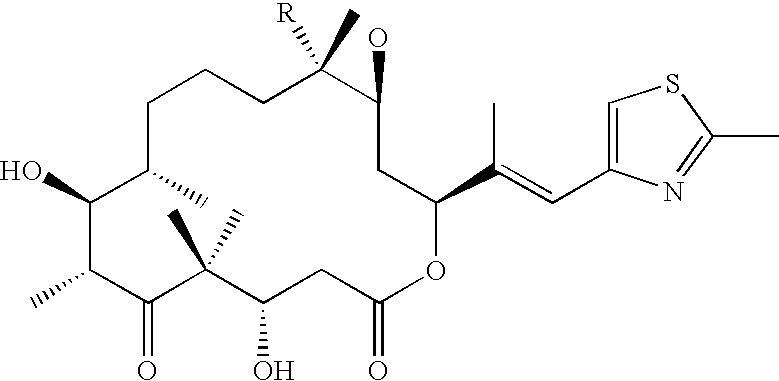Cancer treatment with epothilones
a technology of epothilone and cancer, applied in the field of cancer treatment with epothilone, can solve the problems of reducing the effect of chemotherapy, and reducing the number of chemotherapy treatments
- Summary
- Abstract
- Description
- Claims
- Application Information
AI Technical Summary
Benefits of technology
Problems solved by technology
Method used
Image
Examples
example 1
Determination of the Maximal Tolerated Dose (MTD)
[0207]The results from the maximal tolerated dose (MTD) study are presented in Table 1 and Table 2.
[0208]
TABLE 1Determination of the single i.v. dose MTD for epothilone B innormal female BALB / c mice.Body Weight(mean g ± SD)DoseΔ (p value)% ChangeMortalitiesExperiment 112−5.4 ± 2.9−23.6 ± 11.93 / 3(p = 0.085)10−5.6 ± 0.6−24.9 ± 1.63 / 3(p = 0.003)8−5.1 ± 3.2−22.1 ± 13.13 / 3(p = 0.110)6−6.1 ± 0.9−28.6 ± 3.51 / 3(p = 0.007)Experiment 28−5.0 ± 1.0−25.3 ± 3.93 / 3(p = 0.013)6−5.3 ± 0.6−27.5 ± 2.12 / 3(p = 0.004)4 1.3 ± 0.6 6.5 ± 2.60 / 3(p = 0.057)2 2.3 ± 0.6 12.3 ± 3.00 / 3(p = 0.02)
[0209]Epothilone B is given as a single i.v. bolus dose at 2, 4, 6, 8, 10 or 12 mg / kg. Survival and body weights of the mice are monitored daily. Changes (Δ) in body weights are determined comparing the last measured body weight to that before treatment.
[0210]
TABLE 2Determination of the single i.v. dose MTD for epothilone B infemale BALB / c nude mice.Body Weight(mean g ±...
example 2
Toxicity of Epothilone B (Two-Week Intravenous Comparative Toxicity Study in Mice)
[0213]In order to assess the sub-chronic intravenous toxicity of epothilone B, a non-GLP two-week i.v. toxicity study in non-tumor bearing, normal female BALB / c mice is conducted, involving analysis of mortality, clinical signs, body weight, food consumption, hematology, clinical biochemistry, urinalysis, and organ weights as well as macro and microscopic examinations. The study is based on two different dosing regimens of epothilone B of 3 mg / kg and 10 mg / kg, respectively, administered on days 1 and 8 (8 animals per group). Half of the animals are killed on day 15 (main group) and necropsy is performed. For the other half (recovery group) a recovery period of 5 weeks is allowed after administration of the second dose before sacrifice and subsequent necropsy on day 43. However, for the 10 mg / kg dose all animals of the recovery group have to be sacrificed prematurely on day 19, due to poor general condi...
example 3
In Vitro Activity of Epothilones Against Cell Lines
[0224]The potent anti-proliferative activity of epothilone B is confirmed for some human cancer cell lines; the results of these experiments are summarized in Table 3. Epothilone B generally exhibits higher potency than paclitaxel, particularly against cancer cells with a multidrug resistant (MDR) phenotype (e.g. KB-8511, HCT-15).
[0225]
TABLE 3In vitro activity of the epothilones against human carcinoma cell lines.IC50-values [nM] for growth inhibition of human carcinomacell lines by epothilone B in comparison to paclitaxel(5 d exposure, mean ± SD, n = 3).Values in parenthesis indicate relative resistance,i.e., IC50 (resistant line) / IC50 (parental line).Cell Lineepothilone BpaclitaxelA549 (Lung)0.19 ± 0.12a3.75 ± 0.92ZR-75-1 (Breast)0.64 ± 0.423.60 ± 1.87HCT-15 (Colon)0.41 ± 0.15 106 ± 54KB-85110.89 ± 0.47b 994 ± 281b(Epidermoid, MDR)(1.25)(343)aPC-3M (Prostate)3.82 ± 0.47c6.74 ± 0.72caMean ± SD, n = 2.b2 d Exposure;c3 d exposureMDR ...
PUM
| Property | Measurement | Unit |
|---|---|---|
| time | aaaaa | aaaaa |
| concentration | aaaaa | aaaaa |
| concentration | aaaaa | aaaaa |
Abstract
Description
Claims
Application Information
 Login to View More
Login to View More - R&D
- Intellectual Property
- Life Sciences
- Materials
- Tech Scout
- Unparalleled Data Quality
- Higher Quality Content
- 60% Fewer Hallucinations
Browse by: Latest US Patents, China's latest patents, Technical Efficacy Thesaurus, Application Domain, Technology Topic, Popular Technical Reports.
© 2025 PatSnap. All rights reserved.Legal|Privacy policy|Modern Slavery Act Transparency Statement|Sitemap|About US| Contact US: help@patsnap.com

